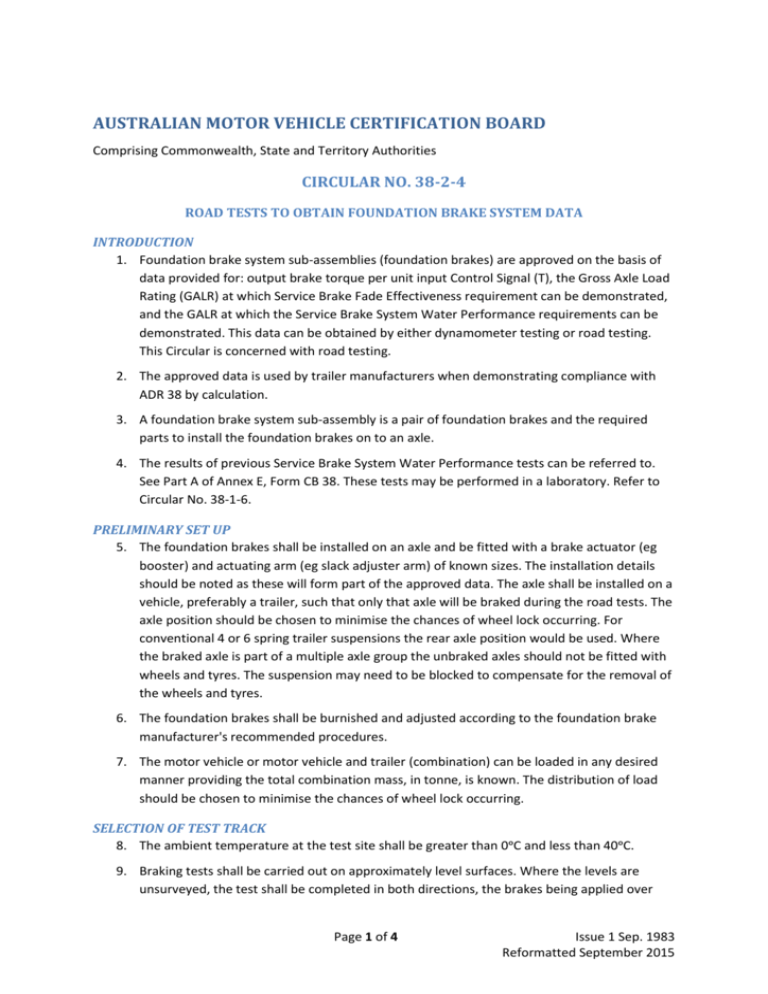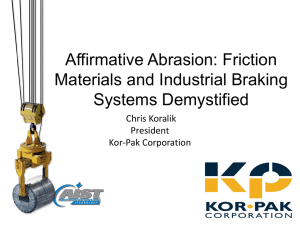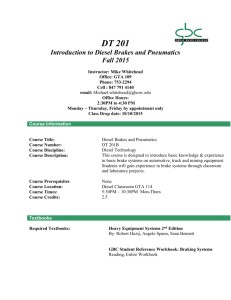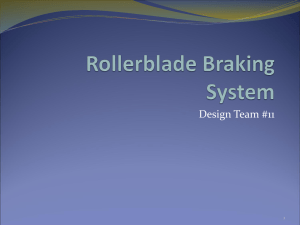circular no. 38-2-4
advertisement

AUSTRALIAN MOTOR VEHICLE CERTIFICATION BOARD Comprising Commonwealth, State and Territory Authorities CIRCULAR NO. 38-2-4 ROAD TESTS TO OBTAIN FOUNDATION BRAKE SYSTEM DATA INTRODUCTION 1. Foundation brake system sub-assemblies (foundation brakes) are approved on the basis of data provided for: output brake torque per unit input Control Signal (T), the Gross Axle Load Rating (GALR) at which Service Brake Fade Effectiveness requirement can be demonstrated, and the GALR at which the Service Brake System Water Performance requirements can be demonstrated. This data can be obtained by either dynamometer testing or road testing. This Circular is concerned with road testing. 2. The approved data is used by trailer manufacturers when demonstrating compliance with ADR 38 by calculation. 3. A foundation brake system sub-assembly is a pair of foundation brakes and the required parts to install the foundation brakes on to an axle. 4. The results of previous Service Brake System Water Performance tests can be referred to. See Part A of Annex E, Form CB 38. These tests may be performed in a laboratory. Refer to Circular No. 38-1-6. PRELIMINARY SET UP 5. The foundation brakes shall be installed on an axle and be fitted with a brake actuator (eg booster) and actuating arm (eg slack adjuster arm) of known sizes. The installation details should be noted as these will form part of the approved data. The axle shall be installed on a vehicle, preferably a trailer, such that only that axle will be braked during the road tests. The axle position should be chosen to minimise the chances of wheel lock occurring. For conventional 4 or 6 spring trailer suspensions the rear axle position would be used. Where the braked axle is part of a multiple axle group the unbraked axles should not be fitted with wheels and tyres. The suspension may need to be blocked to compensate for the removal of the wheels and tyres. 6. The foundation brakes shall be burnished and adjusted according to the foundation brake manufacturer's recommended procedures. 7. The motor vehicle or motor vehicle and trailer (combination) can be loaded in any desired manner providing the total combination mass, in tonne, is known. The distribution of load should be chosen to minimise the chances of wheel lock occurring. SELECTION OF TEST TRACK 8. The ambient temperature at the test site shall be greater than 0ᵒC and less than 40ᵒC. 9. Braking tests shall be carried out on approximately level surfaces. Where the levels are unsurveyed, the test shall be completed in both directions, the brakes being applied over Page 1 of 4 Issue 1 Sep. 1983 Reformatted September 2015 38-2-4 the same section, and the two results averaged to determine the final result. Where the difference in start and finish elevations for a brake test, expressed as a percentage of the stopping distance, is shown, the brake test need only be completed in one direction and the result corrected for any difference in elevation exceeding 1%. 10. The wind speed difference between two tests in opposite directions, or against the direction of travel in the case of a single brake test, shall not exceed 15 km/h. 11. The test surface shall be either concrete or bitumen pavement and shall be free from loose material. TESTING PROCEDURE 12. The initial speed at which braking commences shall be between 58 and 64km/h. 13. Either the stopping distance or the stopping time should be measured from the point where the brake control commences actuation from the 'off' position, to the point where the combination comes to a stop. A calibrated decelerometer and chart recorder may be used instead. 14. The time taken for the Control Signal at the actuator to reach 65% of its final value shall be measured for each Control Signal level used. The value of Control Signal reported shall be the value measured at the brake actuator. 15. No part of the Brake System shall exceed 100ᵒC immediately prior to the commencement of an output brake test sequence. 16. No Trailer wheels shall remain locked, except below approximately 10km/h, during the braking tests. 17. No tow vehicle braking system or other contrived means shall contribute to braking effort. The tow vehicle engine shall be declutched or have neutral engaged during the braking tests. 18. At least five output brake torque tests shall be conducted at approximately equally spaced Control Signal values, measured at the actuator, in the range 0.2E to 1.0E. Wherever possible a test should be conducted at a Control Signal of 1.0E. 19. The actuator stroke shall be measured in millimeters for each test. 20. Service Brake Fade Effectiveness tests should be conducted at one of the Control Signal values used in the output brake torque tests. The foundation brakes shall be first conditioned by conducting 20 successive braked decelerations, each not more than 60 seconds after the preceding one. The initial speed shall be 60 km/h and the final speed shall be calculated from: V₂² = 3600 – 2700 x GALR/Total Combination Mass (tonne) where V₂ is the final speed in km/h, and GALR is the Gross Axle Load Rating claimed for the foundation brakes in tonne. 21. After conditioning the foundation brakes the final braked stop shall be conducted no more than 60 seconds after the last conditioning deceleration. The final stop is a repeat of the brake output torque test (i.e. from 58 - 64 km/h to zero km/h). The brake output torque for that final stop shall be reported. Page 2 of 4 Issue 1 Sep. 1983 Reformatted September 2015 38-2-4 22. Service Brake System Water Performance tests should be conducted at one of the Control Signal values above 0.5E used in the output brake torque tests. The foundation brakes shall be conditioned by: a. driving, with the Brakes released, through water of depth not less than 60% of the static loaded radius of the tyres fitted, for a period of at least two minutes. During such period, the combination speed shall not exceed 10km/h, and for at least one minute shall not be less than 5km/h. For this purpose changes from drive to reverse and reverse to drive shall be considered as continuous driving, OR b. simultaneously and continuously wetting all Brakes for a period of not less than 5 minutes. The rate of delivery of water to each Brake assembly shall not be less than 25 litres per minute. In the case of drum brake assemblies the water flow shall be introduced through an aperture in the brake backing plate. 23. Immediately on completion of this procedure the combination will be accelerated until a speed of 40km/h as attained and a distance not exceeding 1.6 km is covered, and then decelerated by applying a Control Signal of not less than 0.2 E (130 kPa) to the Brakes until the combination speed decreases to the speed as determined from below. The sequence will be completed another three times, without the Brakes being applied except for the decelerations specified. The final speed for the water conditioning shall be calculated from; V₂² = 1600 x 1 – GALR/Total Combination Mass where V₂ is the final speed in km/h, and GALR is the Gross Axle Load Rating claimed for the foundation brakes in tonne 24. After conditioning the foundation brakes in this way the final braked stop shall be conducted no more than 60 seconds after the last conditioning deceleration. The final stop is a repeat of the brake output torque test (i.e. from 58 - 64 km/h to zero km/h). The brake output torque for that final stop shall be reported. REPORTING PROCEDURE Output brake torque tests 25. The results of output brake torque tests shall be reported using Part A of Annex B of the submission of evidence Form CB 38. The Sections GENERAL TEST CONDITIONS (except 1. (iii)) and SERVICE BRAKE EFFECTIVENESS TEST (except 2 (ii), (vii) and (viii)) shall be completed. In Annex B replace the term 'ERC' with the term 'torque'. Torque is to be calculated from the test results using one of the following expressions: Torque = 38.7 x V² X Total Combination Mass (tonne) x Static S - K₁V OR Torque = 278 x V T - K₃ loaded tyre radius (m) X Total Combination Mass (tonne) x Static loaded tyre radius (m) where: V is the initial speed Page 3 of 4 km/h Issue 1 Sep. 1983 Reformatted September 2015 38-2-4 S is the stopping distance m T is the stopping time sec. K₁, for stopping distances, = 0.09/0.32 X t K₃, for stopping times, =t where t is the time in seconds for the Control Signal at the actuator to reach 65% of its final value. Note: The Control Signal to be reported is the value measured at the brake actuator. 26. The values for output and actuator stroke for each Control Signal value shall be reported in Section 2 of Annex I in Form CB 38. 27. Where a Control Signal value of 1.0E was not used in an output brake torque test the torque obtained at a Control Signal value of 0.8E or greater may be increased pro rata to give the output torque per 1.0E Service Brake Fade Effectiveness test. 28 . The results of Service Brake Fade Effectiveness tests shall be reported using Part A of Annex B of the submission of evidence Form CB 38. The Sections GENERAL TEST CONDITIONS (except 1(iii)) and SERVICE BRAKE FADE EFFECTIVENESS shall be completed. In Annex B replace the term 'ERC' with the term 'torque’. Torque is to be calculated from the test results using one of the expressions in 25 above. 29. When completing the table in 3 (iii) of Annex B, convert ERC from the lower bound of Fig. 1 in ADR 38 at the Control Signal value used in the Service Brake Fade Test to torque using the following expression; Torque = ERC x Gross Axle Load Rating (tonne) x 9810 x Static Loaded tyre radius (m). and enter 80% of this value. In place of 60% of ERC from Service Brake Effectiveness test in table 3(iii) of Annex B, enter 60% of the torque from the output brake torque test at the Control Signal value used for the Service Brake Fade Test. Service Brake System Water Performance tests 30. The results of Service Brake System Water Performance tests shall be reported using all Sections of Part B of Annex E of the submission of evidence Form CB 38. Instead of calculating ERC calculate torque using one of the expressions in 25 above. When completing Annex E Section 5 convert ERC from the lower bound of Fig 1 in ADR 38 at the Control Signal value used for the Water Performance Test to torque using the following expression; Torque = ERC x Gross Axle Load Rating (tonne) x 9810 x Static Loaded tyre radius (m) and enter 60% of this value. Page 4 of 4 Issue 1 Sep. 1983 Reformatted September 2015






